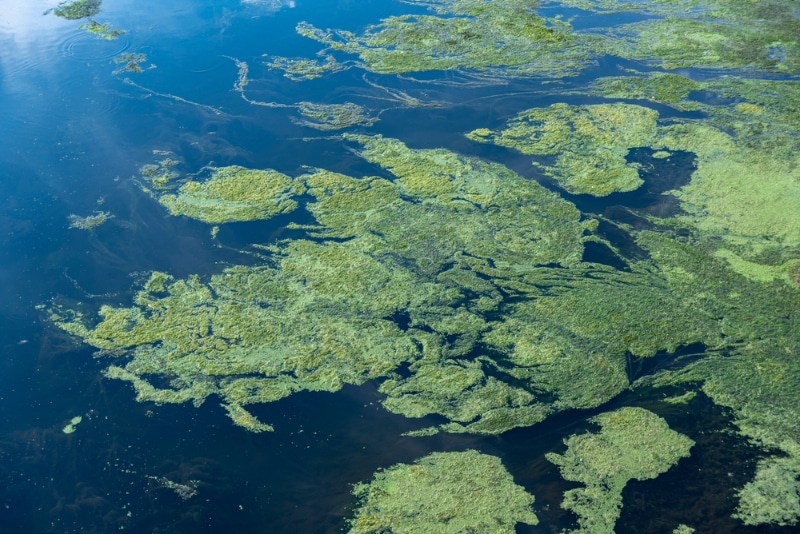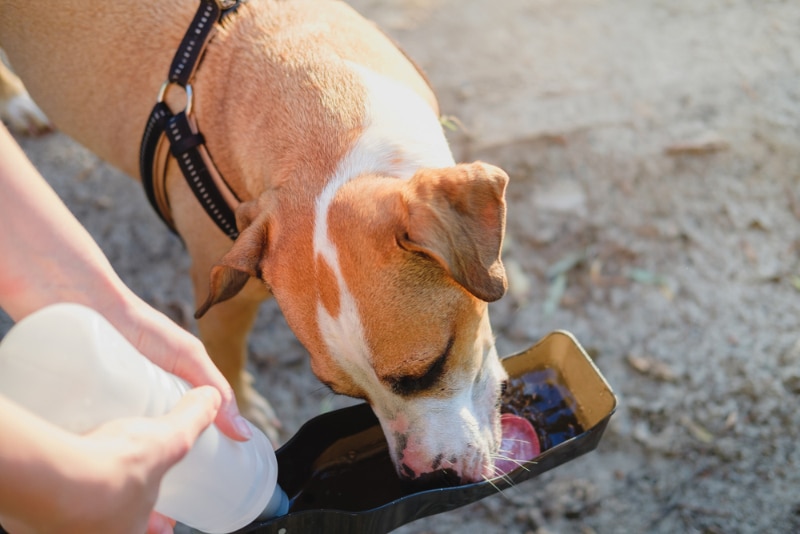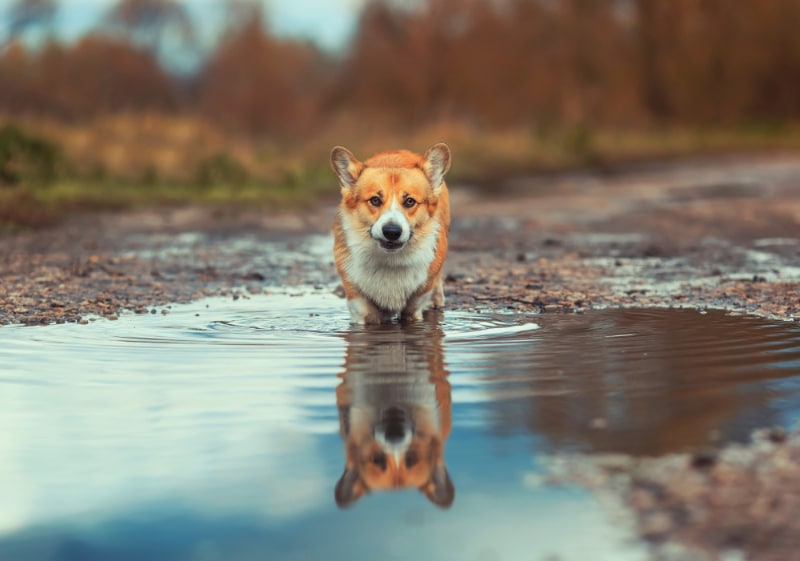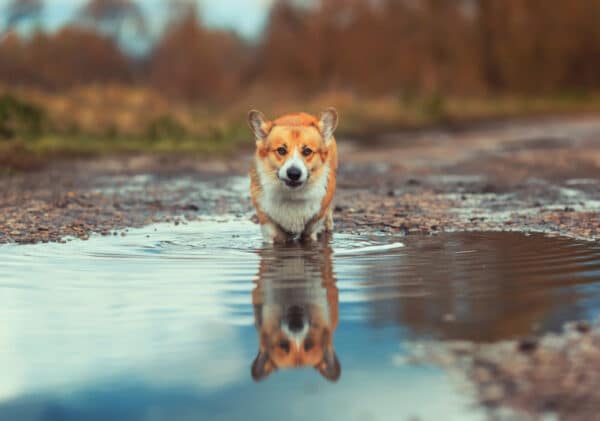Click to Skip Ahead
Dogs need water to survive because it helps their body function the way it should. It’s your job as a loving and responsible dog owner to make sure your dog always has access to clean water. At home, keep your dog’s water bowls in easy-to-reach spots and clean them regularly. If you take your dog out for a walk, bring along a water bottle with an attached cup for them to drink from. If your dog is thirsty, they’re going to look for a water source to drink from, even if it’s dirty, which can be dangerous.
Although your dog may drink dirty water and be fine, it does come with risks. You should never let your dog drink from water that you haven’t placed down for them. Water from ponds, puddles, and small lakes can contain various types of microscopic organisms that can make your dog terribly ill. Let’s discuss the dangers of dirty water.
The Dangers of Dogs Drinking Dirty Water
Stagnant water, especially in warm areas with high rainfall, can be home to harmful organisms that can cause waterborne diseases in dogs. Some types can cause a bit of gastrointestinal upset, while others can cause severe signs such as kidney damage and other severe diseases, necessitating hospitalization. Regardless of how severe your dog’s signs are after drinking or playing in bodies of water, you need to seek out medical assistance.
Some harmful organisms found in dirty water include:
Blue-green Algae
Blue-green algae, otherwise known as cyanobacteria, looks like bright-colored foam that sits on the surface of ponds, lakes, and marshlands. These dense algal blooms produce toxins that, if ingested, can be fatal for your dog.
You’ll know if your dog ingested water with blue-green algae because severe signs will arise quickly. It’s important to act fast and get your dog to your veterinarian as soon as you notice any signs. These signs will include vomiting, diarrhea, rashes, seizures, organ damage, breathing difficulty, loss of consciousness, and, in some cases, death.

Giardia
Giardia is a tiny parasite found in contaminated water. If your dog drinks dirty water that contains Giardia parasites, they could become infected with them. It causes gastrointestinal upset, with signs that include lethargy, diarrhea, loss of appetite, vomiting, and abdominal pain. Giardia is contagious, and signs can range from mild to severe.
Pythiosis
Pythiosis can cause a previously healthy dog to become extremely thin and experience vomiting and diarrhea, but other than these few signs, most dogs don’t appear very ill until much later when their skin develops ulcers that don’t heal. It also causes the gastrointestinal tract to thicken and, potentially, blockages to develop.
Although pythiosis doesn’t seem too serious at first, treatment includes hospitalization, antifungal therapy, removing any infected tissue through surgery, and various other treatments. Sadly, the prognosis is poor, especially if the dog isn’t treated quickly.
Leptospirosis
These bacteria can also be found in dirty water, especially in rural areas, and travel in the bloodstream of the dog that ingested it. Signs usually start showing within a week, which can make it difficult to pinpoint what could be causing them. Signs can include lethargy, vomiting, diarrhea, fever, pain, swelling, bleeding gums, bleeding, coughing, and dehydration. It can also lead to organ failure.
Do Dogs Care If Their Water Is Dirty?
If your dog doesn’t have access to clean water, they’ll be tempted to drink from puddles, lakes, and even the toilet bowl. Some dogs are more sensitive than others when it comes to drinking dirty water, but many dogs don’t like the taste of old, stale water and will drink less water than they should. Instead, always provide fresh, clean water in their bowls or opt for a dog water fountain, as dogs love running water.


Safety Tips When Giving Your Dog Water
Dogs need to drink roughly 1 ounce of water per pound of body weight, so if you have a Labrador Retriever that weighs 70 pounds, they should be drinking around 70 ounces of water per day. However, that water should be given to your dog by you, in a clean bowl or water fountain, and not from puddles, swimming pools, and natural water sources.
Keeping your dog safe from dirty water doesn’t mean that you cannot take them to the park, beach, or on hikes; it simply means that you need to be diligent in preventing them from drinking potentially harmful water. You can do this by:
- Getting them a dog water fountain if they enjoy fresh, filtered water.
- Cleaning their bowls regularly with hot water and a pet-safe disinfectant.
- Refilling their bowls with fresh water once or twice a day.
- Keeping the toilet lid closed.
- Keeping them out of the pool area or placing a cover over the pool.
- Place water bowls outside and inside your home.
- Bring a water bottle and bowl with you when you leave the house with your dog.
- Research what harmful organisms are common in your area and risky water sources. Keep in mind that some water can look fine but harbor microorganisms.
- Always keep your dog in your sight when you’re out or around natural sources of water.
Safe Water Sources for Dogs
Whether you offer your dog water in a bowl or fountain or use a collapsible bottle and cup, there are different kinds of water you can give them that is safe for them to drink.
- Tap water. This option is the easiest and most convenient water source because it comes straight out of your faucet. Although it is usually safe for dogs, it may contain a few chemicals, depending on your municipality’s treatment plant. However, if it’s safe for you to drink, it should be safe for your dog to drink.
- Distilled water. This water is free from contamination and minerals because of the filtration process it goes through.
- Purified water. This type of water has been filtered to remove bacteria, algae, fungi, parasites, metals, and chemicals and tastes fresh and clean.
- Spring water. This type of water is naturally filtered and safe to drink at the source. It also contains minerals that are beneficial to dogs and humans.
Conclusion
Although dogs can drink dirty water and be fine, there are risks to it. It is much safer to prevent them from drinking from pools, puddles, lakes, and ponds. These water sources could be contaminated and contain organisms that are harmful to your dog.
Common organisms found in natural water sources are blue-green algae, Giardia, pythiosis, and leptospirosis. Give your dog water that is safe to drink. A few options are tap water, distilled water, purified water, and spring water.
Featured Image Credit: Bachkova Natalia, Shutterstock











